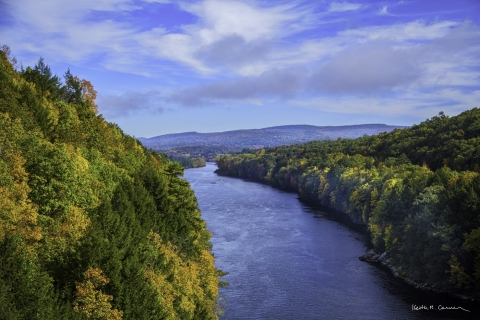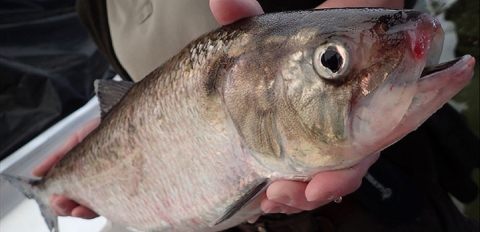TURNERS FALLS, Mass. — Federal, state and nonprofit partners convened at the U.S. Geological Survey’s Anadromous Fish Research Center in Turners Falls today to celebrate a new chapter in cooperative fisheries management in the Connecticut River watershed.
The meeting marked the launch of the new Connecticut River Migratory Fish Restoration Cooperative, which will continue the work of the Connecticut River Atlantic Salmon Commission after its authorizing legislation expires at the end of the month. Congress established the interstate Commission in 1983 to coordinate fisheries management and restoration in New England’s largest watershed, encompassing parts of New Hampshire, Vermont, Massachusetts and Connecticut.
Building upon decades of collaboration, the Connecticut River Migratory Fish Restoration Cooperative will provide a forum for state and federal fish and wildlife agencies and public partners to expand upon their ongoing work to restore and manage native migratory fishes and their habitats in the four-state watershed.
It’s not the first time the partnership has evolved. Well before the Commission was authorized by Congress, state and federal partners formed the Policy and Technical Committee for Anadromous Fish Restoration in the Connecticut River in 1967 in response to a need for inter-agency coordination.
“When that committee came into being, American shad and other sea-run species hadn’t been seen in Vermont or New Hampshire in more than 120 years, and only rarely in much of Massachusetts’ portion of the watershed,” said Ken Sprankle, a fisheries biologist for the U.S. Fish and Wildlife Service. “Both state and federal fishery agencies realized restoring and managing these species required a cooperative approach.”
Sixteen years later, Congress created the Commission to build upon this momentum, focusing on Atlantic salmon as the poster child for the needs of migratory species in the watershed.
The formal effort to restore Atlantic salmon in the Connecticut River ended in 2012 after persistently poor adult survival rates, likely due to changing marine environments. But the collaborative work to reconnect and restore hundreds of miles of river habitat continued, to the benefit of many other species, including alewife, blueback herring, American eel and American shad.
With Congressional authorization for the Commission set to expire on October 28, 2023, the partners recognized an opportunity to adapt to changing needs.
“The Commission has always worked to conserve and restore all the river’s migratory species. But that sometimes felt a bit awkward under a compact that focused almost exclusively on salmon,” explained Bill Hyatt, who served as Commission chair during his tenure as Bureau Chief for Natural Resources for the Connecticut Department of Energy and Environmental Protection. “The new Connecticut River Migratory Fish Restoration Cooperative is a perfect recipe for the work that needs to be done going forward.”
Reflecting on milestones
Over the course of four decades, the Commission supported measurable progress in migratory fish restoration and management by bringing partners together to identify shared needs and draw on the best available science to address them.
During regular meetings each spring and fall, the Commission’s Technical Committee members worked collaboratively to tackle longstanding issues and seize new opportunities.
For example, the Commission pooled expert input to produce management plans for four priority species in the watershed — American eel, river herring, sea lamprey and American shad — but it also took the American shad plan a step further by developing an associated Fish Passage Performance addendum laying out performance metrics for hydropower facilities.
That addendum is folded into the Federal Energy Regulatory Commission settlement agreements for the Northfield Mountain Pumped Storage and Turners Falls projects in Massachusetts and the Great River Hydro projects in Vermont and New Hampshire. It has been used as a model for fish-passage performance metrics in other watersheds.
Communication and coordination with hydropower facility operators, both small and large, has been an ongoing emphasis for the partnership. Every year, the Commission provides a fish-passage operational schedule to all operators in the basin to inform actions to protect fish and their habitats.
The Commission directed federal funds to science needs for advancing migratory fish management as well, including purchasing new fish sampling equipment, hiring seasonal staff to conduct surveys, and supporting research by the U.S. Geological Survey to improve passage for American eel, American shad, blueback herring, alewife and shortnose sturgeon.
Recognizing the importance of community input and engagement, the Commission also partnered with the nonprofit Connecticut River Conservancy on angler surveys, fishway counts, outreach and education, and community science and monitoring initiatives, like sea lamprey nest surveys.
Staying the course
The newly formed Cooperative will continue the legacy of effective and efficient coordination to achieve mutually agreed-upon goals among existing partners, while developing relationships with new partners to further leverage resources and improve outcomes.
A Memorandum of Understanding (MOU) signed by the U.S. Fish and Wildlife Service, NOAA Fisheries and each of the four basin state wildlife agencies — Connecticut, Massachusetts, Vermont and New Hampshire — lays out contemporary goals for the Cooperative, focusing on a diverse suite of activities necessary to restore migratory fishes and their habitats. As was the case for the Commission, each state agency will appoint one public member to the Cooperative to broaden its perspective.
“The reauthorization of the state, federal and public partnership to restore all the migratory fish species of the four-state Connecticut River watershed is a testament to the success and continued potential of cross-border and watershed-scale management,” said Andrew Fisk, Northeast regional director for American Rivers and former Commission chair.
The name may be different, but the underlying mission of the new Cooperative remains the same as that of its predecessors: fostering collaboration among partners to accomplish more for native migratory fish than any entity could alone.




